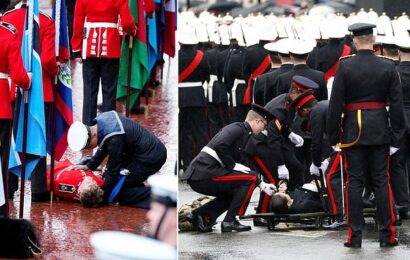Princess Margaret accused the Royals of ignoring her mental anguish – years before Diana and Meghan: ANDREW MORTON reveals how she took pills and whisky, sobbed on chauffeur’s shoulder and threatened to throw herself from window
- Princess Margaret slipped easily into the ‘black sheep’ sibling stereotype
- As marriage to Lord Snowdon fell apart she was smoking & drinking excessively
- Once phoned a friend threatening to throw herself from her bedroom window
- Sign of her devastation was that she sobbed on shoulder of Larkin, her chauffeur
When Princess Margaret was aged six, she learned that her father had become King and that her older sister Elizabeth would one day become Queen. Her response was revealing. ‘I am nobody now,’ she told her nanny. As a Royal second sibling, it was a feeling that would haunt her until her death in 2002.
The dynamic between Queen Elizabeth II and Margaret was, like that between Princes William and Harry today, a highly complex one. It was also one whose illuminating intricacies have been surprisingly neglected by Royal biographers.
Although at times suffocatingly close – the sisters wore identical clothes until Elizabeth was in her teens – their relationship was at other times marked by dramatic sibling tensions that shook their tight bond to its core.
The conflicts began early.
The dynamic between Queen Elizabeth II and Margaret was, like that between Princes William and Harry today, a highly complex one. It was also one whose illuminating intricacies have been surprisingly neglected by Royal biographers.
During a fitting for their father’s coronation in 1937, Margaret, threw a tantrum when she saw that the train to Elizabeth’s dress was a foot longer than hers.
Her mother coldly explained that because of her sister’s seniority of birth, she was entitled to that privilege. It was a moment that for ever rankled with Margaret.
And when 18-year-old Elizabeth was allowed by her parents to participate in the war effort by joining the women’s Auxiliary Territorial Service in 1945, Margaret, then 14, was consumed with jealousy, according to their nanny Marion Crawford.
‘As usual she was very cross at seeing Lilibet [the family name for the Queen] do something without her,’ she observed. Elizabeth, meanwhile, told Crawford: ‘Margaret always wants what I’ve got.’
It’s fair to say that in the popular imagination, every generation of the House of Windsor is stalked by a shadow. The good versus the naughty Royal. The rebellious extrovert versus the sensible introvert.
William the straight shooter, Harry the wild child. Diana the demure, Fergie the roustabout. The Sun and the Moon.
These stereotypes often mask as much as they reveal. And yet, each set of Royal siblings – like all siblings – feeds off this asymmetry.
The Queen and Margaret were no exception. As Margaret told one friend: ‘When there are two sisters and one is the Queen who must be the source of honour and all that is good, the other must be the focus of the most creative malice, the evil sister.’
Certainly, Margaret slipped easily into the ‘black sheep’ sibling stereotype. Though, that reputation barely disturbed the ash on her ever-present cigarette holder.
As she once remarked: ‘Disobedience is my joy.’
Although at times suffocatingly close – the sisters wore identical clothes until Elizabeth was in her teens – their relationship was at other times marked by dramatic sibling tensions that shook their tight bond to its core. The conflicts began early. Pictured: The sisters in 1940
Margaret never for one moment indicated that she wanted to switch places with her sister.
Indeed, when first told that Elizabeth would be Queen she said: ‘Poor you.’
While Margaret chafed at the restraints of Royal life, Elizabeth dutifully embraced them. The sisters were contradictory and conflicted, butting heads over matters both small and monumental, but they also loved one another dearly.
Both had their burdens to carry. Elizabeth knew from a young age that she would have to live up to her family’s and society’s expectations. Meanwhile, Margaret constantly anticipated the humiliation of being second best.
This push-and-pull between affection and distance, deep love and primal jealousy, lay at the heart of their private world.
Sunday newspaper reports following the accession of the two girls’ father, George VI, to the throne in 1936, set the tone for what was to come. The coverage had a selection of charming portraits of the new young heir presumptive, ‘our Princess Elizabeth’.
By contrast, pictures of Margaret were sidelined to group family photos. On the grey, misty morning of the Coronation in 1937, the two girls rode in a state coach to Westminster Abbey.
Margaret’s seat was raised so the crowds could glimpse her through the windows – but it was the future Queen they wanted to see.
The family’s move to Buckingham Palace from their home in Piccadilly created, according to Marion Crawford, ‘a glass curtain… between you [the young princesses] and the outer world’. The two girls relied totally on each other for companionship, spending much of their time staring out of their windows at people passing below. From this point, Elizabeth was granted privileges denied to Margaret.
To prepare for her eventual duties, her studies included lessons in history and the constitution, with a tutor from Eton who came to Buckingham Palace to teach her.
Because neither sister went to school, Margaret was left largely to her own devices – a situation that was, as she later told biographer Christopher Warwick, ‘a bone of contention’.
Her activities included dancing, sewing, knitting and drawing.
‘Margaret did resent her lack of education very much,’ says Royal historian Hugo Vickers. ‘She blamed her mother for it. I don’t think she ever forgave her.’
During a fitting for their father’s coronation in 1937, Margaret, threw a tantrum when she saw that the train to Elizabeth’s dress was a foot longer than hers. Pictured: The Queen Mother (Elizabeth Bowes Lyon) with her daughters Queen Elizabeth (left) and Princess Margaret (right) in 1937
She also envied Elizabeth’s ever-closer bond with their adored father. ‘When they went into the garden together, her arm went spontaneously around his waist and he pulled her towards him,’ recalled Royal photographer Lisa Sheridan.
‘They seemed to have their own little jokes together. Theirs was a special intimacy, more deep than perhaps was usual in an ordinary family.’
Margaret’s response was to play up in order to get attention. She grew unused to hearing the word ‘no’ and was rarely told off when she did wrong. In fact, her naughtiness and high spirits often made her parents laugh.
Elizabeth, however, with her ingrained sense of right and wrong, was deeply perturbed by how Margaret’s often rude behaviour would look to others. ‘Stop her, Mummy. Please stop her,’ she would plead with her mother.
In 1947, Margaret accompanied her parents and sister on a ten-week visit to South Africa.
It was inevitable that Elizabeth, as the future Queen, was the focus of attention.
Margaret’s role, noted the courtier Peter Townsend, who later became her lover, was ‘a relatively thankless one’.
By then a glamorous, vivacious 16-year-old, Margaret realised that if she wanted to find adventure and fulfilment, she needed to look outside Britain, a place where she was doomed to live in perpetual shadow. Further challenges lay in store for her that year when Elizabeth’s engagement to the handsome young Naval officer Philip Mountbatten was announced. Margaret was once again overwhelmed with jealousy.
Her sister had her father’s undivided attention and now a sweetheart. She must have felt she had been demoted even further, from second best to third wheel. It hurt.
She also seethed at the news that her sister now had a lady-in-waiting and her own sitting room, decorated with attractive antique furniture and soft furnishings. It marked a step-change in their relationship, doubtless bringing home to Margaret the realisation that, though she was more talented and intelligent than her sister, she would always play second fiddle.
Margaret, according to friends, may have felt, even briefly, that she had the right personality to be monarch. As their friend Alathea Fitzalan Howard wrote in her diary: ‘Margaret is far and away more the type I would like for the future Queen.’
Margaret’s response was to play up in order to get attention. She grew unused to hearing the word ‘no’ and was rarely told off when she did wrong. Pictured: Princess Elizabeth (left) and Princess Margaret on a pony cart in the garden of their wartime country residence in Windsor in 1940
Conversely, as Elizabeth grappled with the details of the constitution, she would probably have told her little sister to tackle all the hard work before wishing for the Crown herself. Whatever Margaret’s feelings of jealousy and resentment, her sister’s wedding day in November 1947 had a shattering impact.
When the celebrations were over, Margaret spoke emotionally to Marion Crawford about her deep sense of loss. ‘I can’t imagine life here without her,’ she said.
Her friend, playmate, counsellor, companion and adviser was gone. It was the end of an era.
In the spring of 1960, Margaret married her own sweetheart, the charismatic high society photographer Antony Armstrong-Jones, later Lord Snowdon, in a ceremony watched by a TV audience of 20 million.
Decades before Prince Harry and Meghan Markle were flag-bearers of the progressive and global, Margaret and Tony established themselves as Britain’s hippest couple, peerless representatives of the Swinging Sixties and proof the Monarchy could be both traditional and modern.
Vibrant, dynamic and glamorous, they captivated the nation, whizzing about London on a motorbike and injecting new life into what Prince Philip called ‘the Firm’.
As a wedding present, Margaret was given a plot of land on the private Caribbean island of Mustique by a former boyfriend, Colin Tennant, allowing her to build a house where she could finally escape the cloying confines of Britain for several weeks of the year. No longer the odd one out, she had a happy marriage like her sister, with the two speaking and meeting often. But within just a handful of years, the dream was to turn sour. The resulting and devastating toll on Margaret’s mental health would go on to expose an immense and significant gulf of understanding between the Royal sisters.
The first indications of the problems that would plague Margaret throughout her adult life had surfaced following the death of her father in 1952.
Utterly inconsolable, she could barely eat or sleep, depending on sedatives to numb her grief. One newspaper reported that she had been given bromides for four days to calm her nerves.
The woman who had been the life and soul of every party became reclusive and withdrawn, later confessing that ‘there was an awful sense of being in a black hole [and] feeling tunnel-visioned’.
Margaret’s role, noted the courtier Peter Townsend, who later became her lover, was ‘a relatively thankless one’. Pictured: Princess Margaret with Peter Townsend during the royal South Africa tour in 1947
In the mid-1960s, as her marriage began to fall apart, Margaret’s mental health troubles took a more serious turn.
Over Christmas in 1966, friends observed that the princess was smoking and drinking excessively. Melancholic and despairing, she took to calling them in the dead of night.
‘She would ring at one or two in the morning,’ recalled one. ‘You would dress and go round and there she’d be in floods and the whisky bottle would be empty.’ In the new year of 1967, Margaret was admitted to King Edward VII’s Hospital in Central London. Although supposedly there for a ‘check-up’, rumours circulated that the princess had made a cry for help by overdosing on pills and alcohol.
The previous weekend, Margaret had phoned a friend while he was hosting a party, threatening that if he did not check on her immediately, she would throw herself from her bedroom window.
The friend frantically phoned Elizabeth at Sandringham, who replied calmly: ‘Carry on with your house party. Her bedroom is on the ground floor.’
The Queen’s response matched that of the Queen Mother and other members of the Royal Family.
They lived in a world where illness was dealt with by going for a long walk – and mental illness was ignored. As with the Queen’s approach to central heating – ‘if you are cold, put on a sweater’ – her response to sickness, especially her sister’s, was brisk and no-nonsense. A generation later, Princess Diana experienced similar uncomprehending indifference when she suffered from the eating disorder bulimia nervosa.
And yet another generation on, Meghan Markle would dramatically accuse the Royals of being equally indifferent to her own struggle with suicidal feelings and alleged racism.
In 1971, when news of an affair between Armstrong-Jones and the aristocratic model Lady Jacqueline Rufus Isaacs broke in the American press, relations between Margaret and her husband descended, according to a friend, into ‘open warfare’.
A sign of Margaret’s devastation was that she sobbed on the consoling shoulder of Larkin, her chauffeur.
Given the fact that she could normally spend an entire road journey without uttering a civil word to him, this indicated the depths of her despair.
As her friend Colin Tennant, now Lord Glenconner, later remarked: ‘Let’s face it, Princess Margaret was a depressed person, and in the Royal Family you are not allowed to be depressed. In her circle, you didn’t mention the word.’
Another friend cautioned: ‘No one is allowed to be ill in that family. But the family’s lack of understanding is making the princess’s moods even blacker.’
Despite everything, Margaret was not above giving vent to the jealous rages that had consumed her as a young woman.
A generation later, Princess Diana experienced similar uncomprehending indifference when she suffered from the eating disorder bulimia nervosa
During a visit to Windsor Castle, the then Prime Minister Harold Macmillan was startled when Margaret, clad in a dressing gown, entered the Queen’s sitting room and yelled: ‘No one would talk to you if you weren’t the Queen!’, before gathering up her gown and stalking out.
A shocked PM felt that he had been witness to a domestic drama he had no right or wish to see.
But Elizabeth forgave her sister much, taking the rudeness with her usual stoicism. She had always felt responsible for Margaret and time had not changed that sentiment.
Margaret’s late-40s and early-50s saw the relationship between the Royal sisters reach its lowest ebb as her increasingly turbulent love-life and a slew of negative publicity took their toll.
The princess’s home in Mustique had by this time become synonymous with what was perceived as Margaret’s extravagant and excessive lifestyle.
Without the clearly defined duties and commitment that Elizabeth displayed towards the Crown, she appeared to be merely a Royal hanger-on, sponging off the public.
Matters came to a dramatic head during her eight-year on-off affair with Roddy Llewellyn, a gardener and writer 17 years her junior.
At one point in their fledgling relationship, caught in the middle of the warring Snowdons and entirely out of his depth, Llewellyn suffered a mental breakdown, ending up in hospital in Central London.
His collapse left Margaret in tatters. Unable to sleep, she took too many tranquillisers and had to cancel all her Royal engagements.
Margaret’s late-40s and early-50s saw the relationship between the Royal sisters reach its lowest ebb as her increasingly turbulent love-life and a slew of negative publicity took their toll. Pictured: Princess Margaret in 1990
On November 15, 1974, it was announced that she had caught a severe chill.
However, rumours persisted that she had tried to commit suicide. She retreated to her bedroom and refused to leave. Her friends had to rotate caring for her day and night until exhaustion finally pushed one of them to call Elizabeth.
Though not naturally empathetic to sick people, the Queen set aside her engagements and drove to Kensington Palace to see her ailing sister.
They spent the weekend together at Windsor, where Elizabeth was able to find out what was really going on.
While reluctant to become directly involved in Margaret’s dramas, always hoping that they might resolve themselves, on this occasion she played her ‘big sister’ role to perfection, offering advice that Margaret might not have taken from her friends.
The next twist in the marital drama shocked even Margaret’s unflappable sister, however. In June 1975, after recuperating in the Welsh countryside, Llewellyn joined a commune at Surrendell, a farm in Wiltshire where some of his aristocratic and artistic friends were attempting to create a self-sufficient community.
Margaret was intrigued and decided to visit.
Turning up in a Rolls-Royce, she joined Roddy and his friends round the camp fire, singing show-tunes with her drink and ubiquitous cigarette in hand and staying overnight. This created front-page headlines around the world and caused panic at Buckingham Palace.
In a summer when punk bands such as the Sex Pistols were starting to put two fingers up at the Establishment, Surrendell was seen as a provocative outpost of skinny-dipping, free love and pot-smoking. Indeed, its days were soon numbered when the police discovered almost 300 cannabis plants under cultivation.
While the Queen sympathised with Margaret’s marital difficulties, she was not so forgiving of her sister’s retreat to a colony of aristocratic hippies, nor of her relationship with an apparently rootless drop-out.
‘What are we going to do about my sister’s guttersnipe life?’ she lamented to her private secretary, Lord Charteris.
Worse was to come.
It’s fair to say that in the popular imagination, every generation of the House of Windsor is stalked by a shadow. The good versus the naughty Royal. The rebellious extrovert versus the sensible introvert. William the straight shooter, Harry the wild child. Diana the demure, Fergie the roustabout. The Sun and the Moon.
On February 1, 1976, a series of fuzzy photos appeared in a Sunday newspaper showing Margaret, then still married, and Llewellyn sitting together at a bar on Mustique. He was wearing Union Jack swimming trunks, she was in a one-piece swimsuit.
The pictures looked intimate enough to be compromising, leading to a furious phone call from the Queen to her sister.
‘How could you do this to me, to the family, to the Monarchy?’ she was quoted as saying. ‘How could you have been so silly?’
Waves of disapproval and vitriol were now lapping around the gates of the Monarchy, with the image of the self-indulgent princess and her toyboy lover fixed in the public imagination.
It was even suggested during discussion between Royal advisers and politicians that Princess Margaret should be removed from the Civil List and allowed to lead a private life.
According to one newspaper report, however, the Queen strenuously objected to this proposal, pointing out how much her sister did to support her and the Monarchy. She had been given a bad rap. There the matter remained.
As for Roddy Llewellyn, the Queen refused to allow him to visit any of her homes, both before and after the Snowdons’ eventual divorce – the first in the Royal Family for more than 400 years.
Possibly for the first time in their lives, the sisters were now in direct conflict, with many wondering how long this increasingly awkward stand-off would last.
They did not have long to wait. In 1981, Roddy announced his engagement to somebody else.
Margaret, by now 51, was shocked, but although she had lost a lover and friend, she regained her sister.
From this point on, she re-dedicated herself to supporting the Queen, recognising that she would always be in her shadow and finally accepting her younger royal sibling status. As she commented at the time: ‘Still playing second best after all these years. I guess I’ll be second best to my grave.’
When Princess Margaret died in 2002 at the age of 71 after a series of strokes, the Queen seemed overwhelmed by the loss of the sister she had spoken to on the phone every day.
Decades before Prince Harry and Meghan Markle (pictured) were flag-bearers of the progressive and global, Margaret and Tony established themselves as Britain’s hippest couple
As the coffin was placed into a hearse after the funeral service, one hand gripped that of Margaret’s daughter Sarah Chatto, while the other brushed away tears.
Margaret’s passing concluded a complex saga of two sisters united yet divided by love and duty.
One preferred the routines and rhythms of a rooted traditional aristocratic lifestyle, the other invented herself as a daring, flirtatious party-goer mingling with celebrities, artists and bohemians.
She embraced the exotic and the subversive, creating a life for herself outside of the confines of Britain.
But for all their differences, both shared one enduring, deeply rooted trait: loneliness.
Both sisters were universally known and almost constantly surrounded by people. Yet in so many ways they remained indecipherable to everyone but each other. Always at the centre of public attention, neither ever fully enjoyed ‘normal’ relationships.
It was from this position of magnificent isolation that the sisters forged their inseparable, intuitive bond.
At her sister’s christening in October 1930, Elizabeth had whispered as she gazed at her baby sister in adoration: ‘I shall call her Bud. You see, she isn’t really a rose yet.’
In many ways, Margaret would always remain the bud, representing unfulfilled potential, someone restrained by convention and longing to burst forth, while her sister evolved into a full Royal ‘rose’.
One a bud, and one a rose. But both were grafted from the same branch.
Abridged extract from Elizabeth & Margaret: The Intimate World Of The Windsor Sisters by Andrew Morton, published by Michael O’Mara on March 30 at £20. To pre-order a copy for £17.60 go to mailshop.co.uk/books or call 020 3308 9193 before April 18. Free UK delivery on orders over £20.
Source: Read Full Article
















